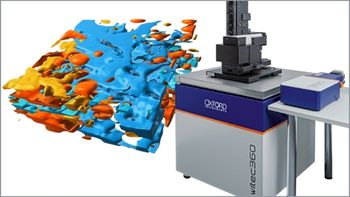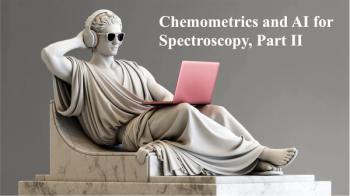
Ready to Fly: Raman Spectroscopy in Planetary Analysis
In this interview with Spectroscopy, renowned planetary spectroscopist Alian Wang of Washington University in St. Louis discusses the development of the Mars microbeam Raman spectrometer (MMRS), proposed to be part of science payload for the NASA-funded mission, Mars 2020. Wang discusses the challenges involved in making the instrument robust enough for operation in space, and highlights how data collected from over 18 years has advanced our understanding of the history of Mars.
In this interview with Spectroscopy, renowned planetary spectroscopist Alian Wang of Washington University in St. Louis discusses the development of the Mars microbeam Raman spectrometer (MMRS), proposed to be part of science payload for the NASA-funded mission, Mars 2020. Wang discusses the challenges involved in making the instrument robust enough for operation in space, and highlights how data collected from over 18 years has advanced our understanding of the history of Mars.
Q. How did you enter the field of planetary spectroscopy?A: I was trained in physics, specialized in molecular and laser spectroscopy. When I started to work with a renowned planetary geochemist, former Professor Larry Haskin, at Washington University in St. Louis, he asked what would be my choice of spectroscopy techniques for planetary surface exploration. I said “Raman spectroscopy”. From there, I entered the field of planetary spectroscopy.
Q. Why is Raman spectroscopy your method of choice for planetary analysis? A: Various spectroscopic techniques have been used for mineral identification and characterization from orbital remote sensing and surface exploration. They have difficulties in dealing with the spectra of mixtures, for example, soils and rocks at the surface of planets. In Raman spectra, the peaks of minerals and molecular bonds are very sharp and well separated from each other, which enable direct mineral identification from raw Raman spectra of lunar samples and Martian meteorites. The simplicity in Raman spectra and the non-ambiguity for phase identification were the keys for its application in planetary explorations.
Q. What are the biggest challenges involved in making a Raman instrument robust enough to operate in space? What are the unique features of the instrument you have been designing — the Mars microbeam Raman spectrometer (MMRS)?A: It would be impossible to use Raman spectroscopy for space missions without developments in recent years in the technologies for lasers, detectors, filters, and other opto-electronic elements. Our effort to make a robust Raman system involves raising the technical readiness level of all subsystems, including optics, mechanics, electronics, and thermal design. The engineering team directed by the Planetary Sciences Instruments Office at Jet Propulsion Laboratory (JPL) of National Aeronautics and Space Administration (NASA) has been doing a great job. The key feature of the Mars microbeam Raman spectrometer is the high throughput and a very tightly focused excitation laser beam with scan capability, which gives it high detection sensitivity for a broad range of inorganic and organic molecules, and the capability to link their occurrence with textural features in a rock. We call this “fine-scale definitive mineralogy”.
Q. You have been testing your Mars microbeam Raman spectrometer in extreme environments on Earth that mimic conditions on Mars, such as in the Atacama Desert. How has the instrument performed under those conditions?A: We conducted two field tests of this spectrometer in the Atacama Desert in Chile: A standalone test in 2012 and a test with it installed on the Zoe Rover in 2013. The system performed well and produced some beautiful Raman spectra from surface and subsurface materials. We also learned a lot through those tests under harsh environmental conditions. The next test will be done in 2014.
Q. You began work on the MMRS more than 18 years ago. How has information gleaned from Mars missions during that time advanced your work? A: MMRS was originally part of Athena science payload for Mars Exploration Rover (MER) mission in 1997. Although it was “descoped” from that mission in the middle of its development, our team gained a lot of experience on the rover accommodation requirements through the process. By participating in the MER mission operation as a scientist, I have learned how tactical mission operations are made, and how science payload data are downlinked and used to direct next day’s operation. Through the data analysis and synergistic applications of data from different science instruments, I learned about the surface and subsurface mineralogy and geochemistry of Mars as a planet. During the MER mission, I found evidence for the change in the degree of hydration of subsurface hydrous sulfates after their exposure to Mars surface. This discovery stimulated the experimental studies on the fundamental properties of Mars-relevant hydrous salts carried by my team over the past few years.
All of this knowledge will guide future MMRS development for the next mission to Mars, on issues such as the accommodation of the instrument to spacecraft, mission operation, and the planetary materials that the our instrument will examine.
Q. Are you confident the MMRS will be ready for the 2020 mission to Mars?A: We are ready to fly.
Q. Could your system be used to explore other locations in space beyond Mars?A: Raman spectroscopy can be used for planetary surface explorations on the Moon, Mars, Venus, and even asteroids and comets. My team is currently funded by NASA’s Maturation of Instruments for Solar System Exploration (MatISSE) program to raise the scientific and technological readiness level for that goal.
Q. At the same time that you have been developing a Raman instrument for use in space, you have been using Raman spectroscopy to study the fundamental properties of hydrous sulfates — such as magnesium, ferric, and aluminum sulfates — that are known to be present on the surface of Mars, focusing on the rates of hydration and rehydration of these sulfates. What can that tell us about the history of the presence of water on Mars? A: Hydrous sulfates are one of two major types of secondary minerals (the other type is phyllosilicates) that have been found on Mars, in large quantities and wide distribution. The degrees of hydration of these sulfates at the surface and subsurface on Mars are heavily influenced by environmental conditions, which are subject to diurnal and seasonal cycles, and in the long term, to the cycles of Mars’s obliquity. The determination of hydration degrees of detected sulfates on Mars can shed light on the hydrologic evolution of Mars, and can also provide information about the current water reservoir on the planet. Both of these aspects relate to the potential generation and preservation of Martian life (if that ever happened). Until now, most missions to Mars have only revealed incomplete information about the hydration degrees of the identified sulfates. Laboratory experimental studies on the stability field and reaction rate of hydrous sulfates under Mars-relevant conditions provides fundamental knowledge that can be used to explain the phenomena observed during the past, the current, and the future exploration missions on the planet, and to link these mission observations to geochemical and hydrological processes that could have happened at the surface or within the subsurface of Mars.
Because of the sharp peaks in Raman spectra of those sulfates and their position sensitivities to hydration degree changes, Raman spectroscopy has been the best non-invasive tool that my team used to conduct these laboratory experimental investigations.
Q. What else can Raman spectroscopy tell us about Mars? A: Raman Spectrocopy is an extremely sensitive technique for the detection of carbon, which bears enormous significance for ”Seeking the Signs of Life” on Mars — a goal set for the NASA 2020 rover mission to Mars designed by Mars2020 Science Definition Team. Raman spectroscopy has been used for the characterization of carbonaceous materials in meteorites, interstellar dust particles, and terrestrial materials. Another Raman spectroscopy application is the potential detection on Mars of “biomarkers,” organic materials generated through biological processes (if that ever happened) and preserved over a very long period under the harsh environmental conditions on that planet.
Q. Where do you see your research going in the future?A: The near term plan is to propose an advanced version of the MMRS, the “compact integrated Raman spectrometer” (CIRS), for the NASA 2020 rover mission to Mars, and to continue the laboratory investigation of the thermodynamics and kinetic properties of Mars-relevant hydrous salts.
Alian Wang was born in China, and received her PhD in France. She has been working on NASA-funded projects over the past 20 years at Washington University in St. Louis, Missouri. She is a renowned Raman spectroscopist, specializing in planetary exploration and planetary fundamental sciences. She is the principal investigator of the Mars Microbeam Raman Spectrometer (MMRS) and the Compact Integrated Raman Spectrometer (CIRS) supported by NASA’s Planetary Instrument Definition and Development, Mars Instrument Development Project, Astrobiology Science and Technology for Exploring Planets, and Maturation of Instruments for Solar System Exploration programs. She is a member of science team of the NASA Mars Exploration Rover mission, and a co-investigator for Laser Raman spectroscopy investigation for the ExoMars rover mission under preparation by the European Space Agency. Since 2004, she has served as a member of GeoRaman International Science Advisory Committee (GRISAC), and is the co-chairman of 11th GeoRaman International Conference that will be held June 15-19, 2014 in St. Louis, MO, USA.
Related content:
Newsletter
Get essential updates on the latest spectroscopy technologies, regulatory standards, and best practices—subscribe today to Spectroscopy.





